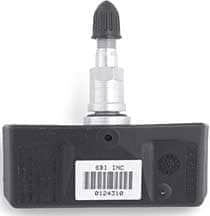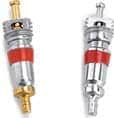Shop by Vehicle for Tire Pressure Monitoring System (TPMS) Sensors
You may want to take a copy of this article to the service center when replacing the tires on your vehicle or when having its tire pressure monitoring system (TPMS) serviced. It might provide some tips not covered by the tire changer's normal service procedures.
Since extra precaution is needed to avoid damaging TPMS during bead loosening and tire dismounting, let the service center personnel know your vehicle is equipped with TPMS, which type of system it has, as well as if you have added aftermarket TPMS.
The presence of standard rubber valves in the wheels normally indicates the vehicle uses an indirect tire pressure monitoring system (TPMS) that compares tire revolutions when the vehicle is in motion by monitoring the ABS speed sensors.
However, beginning with the 2007 model year, some vehicles began using a rubber valve stem direct TPMS that is hard to distinguish visually from a standard rubber valve stem.
Can you easily identify which rubber tire valve stem shown below
is attached to the tire pressure monitoring sensor?
(Roll your mouse across the pictures to find out if you were right.)
Only the rubber TPMS valve's resistance to gentle bending confirms its design.
The presence of aluminum valve stems (shown below left) bolted through the wheels, normally indicates the vehicle uses a direct TPMS in which pressure sensors/transmitters are attached to the wheels.
However, some earlier Corvettes and Ford vehicles have direct tire pressure monitors (shown above right) banded to their wheels.
If a direct TPMS system is in use and the air pressure has been released from the tire, the aluminum tire valve (along with its attached tire pressure sensor) should be unbolted and allowed to gently "drop" into the still-mounted tire and wheel. This will help protect the tire pressure sensors (some exceeding $200 each when purchased from the new car dealer) from being broken during bead loosening and tire dismounting.
The tire should be removed from the wheel following the tire machine's instructions. Click here for run-flat tire mounting tips.
TPMS Replacement Parts for Clamp-In Sensors
Whenever aluminum TPMS sensors are removed from a wheel, the sensor should be fitted with a new rubber grommet (also called an o-ring or seal), aluminum retaining nut, special nickel-plated valve core and valve cap (shown left).
It is important that all components be torqued to appropriate values to prevent air leaks. Attempting to reuse the original rubber grommet, valve core and retaining nut may result in an air leak. Additionally, it is important to retain the original aluminum TPMS sensor's type valve cap.
Note: A standard brass valve core (shown right) used in an aluminum tire pressure sensor valve stem will experience galvanic corrosion and the brass valve core will eventually seize in the valve's aluminum barrel.
Only special nickel-plated valve cores (shown right) should be used in aluminum tire pressure sensor valve stems.
Replacement Parts for Rubber Snap-in Valve Based Sensors
Whenever a rubber snap-in valve based TPMS sensor is removed from a wheel, it should be replaced with new rubber snap-in valve designed to accept a TPMS sensor. Attempting to reuse the original rubber snap-in valve and valve core may result in an air leak.
It is important that the TPMS sensor retaining screw/nut be torqued to the appropriate value.
Shop by Vehicle for Tire Pressure Monitoring System (TPMS) Sensors
Was this post helpful?
750 of 1253 people found this post helpful








